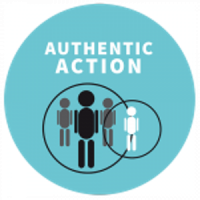Complex, Meidoornkade 22
3992 AE Houten
0343 528 040
3992 AE Houten
0343 528 040

Authentic Action comes from the core of our beliefs and being and contributes to the world around us. Our motivation increases when we focus on how our personal actions connect to and contribute to the bigger business ecosystem that we are a part of.
The success strategy: Focus on added value. We balance personal and collective choices in line with the bigger business ecosystem that we feel a part of. We can discuss this factor using the following success markers: Personal contribution, Choose from a whole, Balanced values, Individual priorities and Improve interaction
We are well aware how our personal work contributes to the final outcome

The following questions might help you to become aware of your contribution (‘mission’):
Focus on ‘customers’ and the overall outcome of the team effort.
Evaluate the team output of the past two weeks:
Identify the relationship between actions, outcomes, and goals.
Review team output in relation to the baseline requirements or objectives.

Our everyday choices are based on feelings, values, and perceptions. Choosing from a whole implies that our choices originate from a bigger perception than just our personal scope of work. Choosing from is a whole is a key to achieving sustainable results which require integration and alignment. Questions to widen your focus:
Teams that choose from a whole have a clear focus on people, systems, information and activities in their business ecosystem.
They base their choices on the shared context and shared values in this ecosystem. To check and balance during a meeting:
What choice do we make right now?
Agile settings: story mapping
Portfolio management settings: multi-criteria analysis
Project settings: Benefit analysis

Finding a proper balance between personal values and team values is a constant struggle and needs to be addressed in teams. A proper balance is a prerequisite for high performing teams that work with the principle of purpose and intent.
It is not easy to balance our values when we are unaware of what is really important to us. One essential question shows the way to our value system:
Use the answers from various situations to find values that are common. Such as safety, harmony, results etc.…
Then evaluate your team setting.
Team values are often implicit and tend to surface in challenging situations. For instance, when a team is facing a higher workload than it can absorb. What is more important in that situation:
As every situation and team is unique there is not just one right general answer. The key message is: make sure the team is aligned. Questions to stimulate alignment in a specific situation are:

Most people feel energized when their individual priorities are aligned with the group focus. The survey shows that there is room for improvement at both the individual and team level. 26% is satisfied but almost the same number of team members is not. The team agility is depending on the ability to set individual priorities, to create a group focus and to take a leading role.
Priorities follow attention and values. Check whether you are on the right track using these questions:
The quality of the shared context and the quality of interpersonal communication is key to setting the right priorities. Check out these other markers:
In every meeting identify other objectives, priorities or activities that might disturb the team flow.
Set the short-term group focus based on three criteria: achievable for all team members, highest value, commitment.

The survey shows that 33% of the team members feel the positive intent of others to improve the social interaction. However 24% of the professionals feels the opposite. The quality and timely delivery of results is depending on the social interaction of all professionals involved.
The quality of interaction is characterized by your personal feeling about:
Depending on the situation the interaction might need a deeper level of improvement:
Evaluate team interaction with the use of the a2Results® Team app using one of the following evaluation topics:
Rien van Leeuwen gaat in op basiscondities voor duurzame verandering.
Aan de hand van praktijk-cases verkennen we de barrières bij het bereiken van duurzame doelen op strategisch, tactisch en operationeel niveau. Denk hierbij aan bestaande structuren en opvattingen, maar ook aan het niet kunnen duiden van negatieve en positieve impact.
We delen onderling de best practices en interventies die anderen activeren. Uiteindelijk draait elke verandering om een andere manier van interactie.
Rien van Leeuwen gaat in op basiscondities voor duurzame verandering.
Aan de hand van praktijk-cases verkennen we de barrières bij het bereiken van duurzame doelen op strategisch, tactisch en operationeel niveau. Denk hierbij aan bestaande structuren en opvattingen, maar ook aan het niet kunnen duiden van negatieve en positieve impact.
We delen onderling de best practices en interventies die anderen activeren. Uiteindelijk draait elke verandering om een andere manier van interactie.